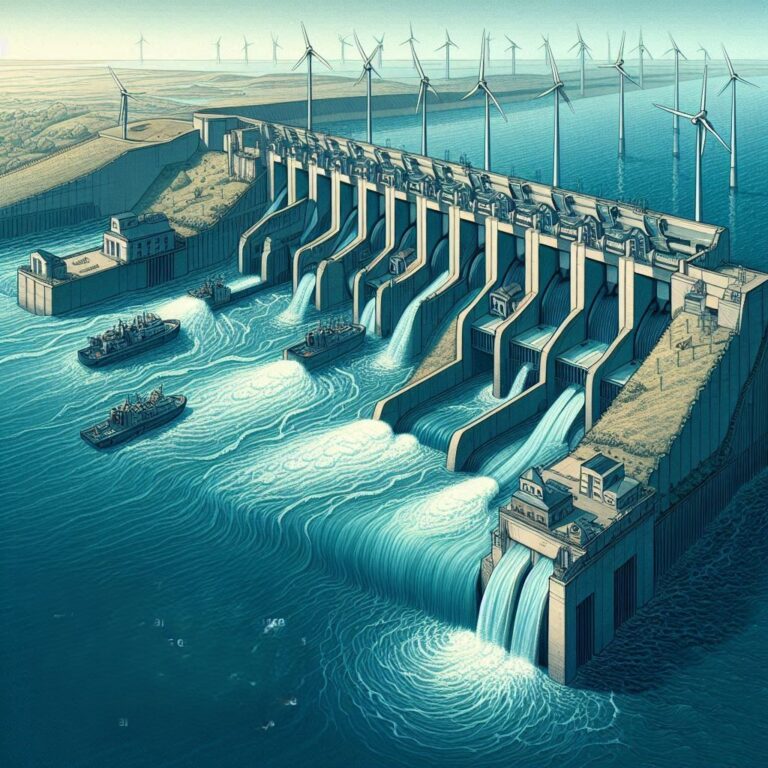Introduction- Steam Engine
The steam engine is an external combustion heat engine that converts thermal energy consisting of steam into mechanical work. Steam requires a boiler to convert water into high-pressure steam, this high-pressure steam is then sent to the cylinder where due to expansion or contraction it exerts a force upon the piston or turbine blades of the steam engine, this motion can be harnessed for work to turn the wheels or drive machines.
The invention of steam engine is considered an important invention that revolutionized the world in the 18th and 19th centuries. It played a key role in driving the Industrial Revolution, and its impact on our lives can be felt today. In this blog, we’ll take a look at the history of the steam engine, its invention, and its impact on society.
It is an essential discovery that played an important role in the Industrial Revolution, it was used for applications like prime movers in water pumps, traction engines, locomotives, steamboats/ ships and road vehicles like lorries. Steam turbines are the kinds of steam engines that are still used today for electricity, the older versions of steam engines are replaced by internal combustion engines and electric motors in many applications.
The invention of steam engine and its development
The Aeolipile’s Whirlwind (1st Century AD):
The earliest mention of steam power comes from Hero of Alexandria’s “Aeolipile.” This rudimentary turbine, while intended for amusement, showcased the potential of steam to create rotational motion. It wasn’t just a toy; it was a seed of inspiration that lay dormant for centuries.
Image Source- MichaelFrey, CC BY-SA 3.0 <https://creativecommons.org/licenses/by-sa/3.0>, via Wikimedia Commons
The Aeolipile, invented by the brilliant Alexandrian engineer and mathematician Hero of Alexandria, was more than just a plaything. It was a testament to the human fascination with harnessing the power of nature. Imagine a spherical vessel with two opposing nozzles angled like jet engines. Inside, water was heated, turning to steam and escaping through the nozzles, propelling the sphere to spin rapidly. While not powerful enough for practical applications, the Aeolipile demonstrated a fundamental principle: steam could create rotational motion.
While Hero’s invention didn’t lead directly to the industrial giants of the 18th century, its influence cannot be understated. It served as a beacon of inspiration for centuries to come. Arab scholars like Taqi al-Din in the 16th century built upon this concept, envisioning steam-powered turbines. Leonardo da Vinci’s famed sketches even featured a paddle-wheel boat, hinting at the potential for steam-powered transportation.
- Hero’s Aeolipile wasn’t just a theoretical concept. Archaeological evidence suggests it was actually constructed and demonstrated, showcasing its practical implementation.
- Some historians believe the Aeolipile might have had religious or symbolic significance, representing the celestial spheres powered by unseen forces, adding another layer of intrigue to its legacy.
- While the exact details of its construction remain somewhat debated, the core principle of steam creating rotational motion remained constant, highlighting the enduring power of this fundamental idea.
Newcomen Engine
With the continuous invention and innovations in steam technologies by various countries, the steam engine continues to evolve. In the 17th century experiments with steam power revealed steam potential that was used steam in pressure cookers and water pumps in coal mines. Thomas Newcomen created the first steam engine after conducting several experiments on steam pumps. Imagine a large beam engine, powered by a steam-filled cylinder that created a vacuum, pulling water upwards. While inefficient (it used a lot of fuel), it was a crucial step towards deeper mines and more coal production.
While not a marvel of efficiency, Newcomen’s engine served a critical purpose: pumping water out of coal mines. This seemingly mundane task fueled the mining industry, paving the way for deeper mines and increased coal production. However, it had drawbacks:
- Fuel Guzzler: It burned massive amounts of coal, contributing to air pollution and resource depletion.
- Cumbersome Design: Its large size and complex operation limited its applications.
- Limited Power: It lacked the power to drive large-scale machinery.
Enter James Watt: The Efficiency Maestro:
In 1763, James Watt, a skilled instrument maker, encountered a Newcomen engine in need of repair. He became obsessed with its inefficiency, particularly the wasted steam. His relentless pursuit of improvement led to the separate condenser, a groundbreaking invention.
This seemingly simple change – condensing steam in a separate chamber – dramatically reduced energy waste and increased efficiency by five times. Watt’s engine became a game-changer, paving the way for:
- Powerful Factories: It powered factories, textile machines, and mills, fueling the Industrial Revolution.
- Revolutionized Transportation: Steamboats, powered by Watt’s engine, transformed trade and travel.
James Watt patented significant improvements in the Newcomen engine that made it much more fuel efficient due to the reuse of steam by the separate condenser rather than being lost. This allowed the steam cylinder to be maintained at a constant temperature which drastically improved the efficiency of the engine.
Further Exploration:
- For a deeper dive into Newcomen’s engine: https://en.wikipedia.org/wiki/Newcomen_atmospheric_engine
- Explore Watt’s groundbreaking improvements: https://www.britannica.com/summary/James-Watt
- Discover the global story of steam power: https://en.wikipedia.org/wiki/Taqi_ad-Din_Muhammad_ibn_Ma%27ruf
Brief timeline of the major events and milestones in the history of the steam engine:
1st Century AD- Aeolipile:
Step back in time to the vibrant city of Alexandria in the 1st century AD. Imagine the cacophony of traders hawking wares, the scent of spices tingling the air, and the sun glinting off the majestic Library. Amidst this bustling scene, a curious mind named Hero of Alexandria tinkers with a seemingly simple contraption – a hollow sphere named the Aeolipile.
More than just a “toy,” the Aeolipile held the seeds of a revolution. This unassuming sphere, powered by the invisible force of steam, hinted at a future where this very force could be harnessed for unimaginable feats. While the practical applications remained hidden in the mists of time, the Aeolipile’s significance lies in its role as the earliest known instance of converting steam into rotational motion.
But who was Hero, the mastermind behind this ingenious creation? Unfortunately, much of his life remains shrouded in mystery. Historians believe he was a mathematician, engineer, and inventor, likely of Greek origin, who spent his days in the bustling intellectual hub of Alexandria. His “Pneumatica,” a treatise on mechanics and pneumatics, detailed not only the Aeolipile but also other fascinating inventions, like the world’s first vending machine and a self-operating temple door.
Despite its revolutionary potential, the Aeolipile’s impact remained limited in its time. Technological advancements and societal needs weren’t yet aligned to fully embrace its potential. However, the spark it ignited continued to flicker. Centuries later, Leonardo da Vinci sketched his own version of the Aeolipile, showcasing the enduring fascination with its concept.
The Aeolipile’s true legacy lies in its prophetic nature. It was the primordial whisper of the steam engine, a technology that would shape the course of human history. From powering locomotives that reshaped continents to turbines generating electricity that illuminates our lives, the echoes of the Aeolipile resonate even today.
13th Century:
Centuries after Hero’s Aeolipile sparked the imagination, the embers of steam power flared anew in the bustling Middle East. Enter Al-Jazari, a 12th-century polymath engineer whose brilliance transcended borders. Unlike the “toy” status of the Aeolipile, Al-Jazari saw steam’s true potential. He designed not just one, but multiple water-raising devices powered by its potent force.
Imagine intricate machines, crafted with skill and ingenuity, using steam to lift water – a vital resource for irrigation and everyday life. This wasn’t mere amusement; it was a pioneering step towards practical applications. While largely unknown in the West, Al-Jazari’s work highlights the global tapestry of steam exploration, reminding us that innovation doesn’t bloom in a single corner of the world.
His achievements serve as a bridge, connecting Hero’s early spark with the later Industrial Revolution. They underscore the fact that the journey of steam power was paved by diverse minds, each adding their unique contribution to this transformative technology.
Around the same time: In China, the renowned Zhang Heng constructs a “steam armillary sphere,” showcasing a similar understanding of steam’s potential. These early explorations, often dismissed as mere curiosities, were crucial sparks, igniting the imagination of future inventors.
1698: Thomas Savery’s Steam-Powered Pump
Imagine the desperation in flooded mines, where lives and livelihoods hung precariously by a thread. This was the pressing reality faced by Spanish engineer Jerónimo de Ayanz y Beaumont. Undeterred by funding challenges and technical hurdles, he dreamt of a solution. His brainchild? A steam-powered pump, patented in 1606, nearly a century before Savery’s invention. While historical details remain scarce, Ayanz’s pioneering spirit highlights the international quest to harness steam’s power, showcasing that innovation wasn’t confined to any single nation.
Fast forward to 1698, and we meet Thomas Savery, an Englishman equally frustrated by the limitations of manual pumps in flooded mines. His steam-powered pump, albeit inefficient and requiring constant intervention, offered a vital lifeline. By creating a vacuum to draw water upwards, Savery’s invention, despite its flaws, saved lives and boosted coal production. It was a crucial stepping stone, showing the practical potential of steam and paving the way for future improvements.
However, Savery’s pump was far from perfect. Its inefficient use of steam and limited power output highlighted the need for further innovation. This is where the story takes another turn, leading us to the pivotal contribution of Thomas Newcomen in 1712. His atmospheric engine, incorporating innovations like a separate condenser and a piston, marked a significant leap forward. It was more efficient, more powerful, and capable of continuous operation, finally ushering in an era of true practicality for steam power.
1712: Thomas Newcomen and the Atmospheric Engine
The true turning point in steam engine history came in 1712 when Thomas Newcomen, another English engineer, unveiled the atmospheric engine. This monumental invention was the first practical steam engine, and its primary purpose was to pump water out of coal mines. It marked the dawn of an industrial revolution powered by steam.
Historical References:
- Savery, Thomas. “The Miner’s Friend, or, an Engine to Raise Water by Fire.” (1698)
- Newcomen, Thomas. “A Description of the Fire Engine or Water Engine invented by Mr. Thomas Newcomen and Mr. Cawley.” (1724)
- Dickinson, H. W. “A Short History of the Steam Engine.” (1938)
- Hills, Richard L. “Power From Steam: A History of the Stationary Steam Engine.” (2002)
1765: James Watt’s Efficiency Improvement
The year 1765 marked a turning point in steam engine history when James Watt, a brilliant Scottish instrument maker, unveiled his separate condenser. This seemingly simple innovation revolutionized the technology. Unlike earlier engines where the cylinder cooled down with each cycle, Watt’s condenser kept the cylinder hot while condensing the steam in a separate chamber. This drastically increased efficiency, reducing fuel consumption by up to 75%.
Historical Significance:
- Inspired by the Newcomen engine’s limitations, Watt’s invention addressed the issue of thermal inefficiency, a major bottleneck in steam power utilization.
- This breakthrough paved the way for the development of more powerful and versatile engines, capable of powering not just pumps but also factories and locomotives.
- References:
- Dickinson, H. W. “A Short History of the Steam Engine.” (1938)
- Hills, Richard L. “Power From Steam: A History of the Stationary Steam Engine.” (2002)
1775: James Watt’s Patent
Recognizing the immense potential of his improved engine, Watt secured a patent in 1775. This was a crucial step, as it granted him exclusive rights to his invention and spurred further investment and development. The patent also helped prevent unauthorized copying, protecting Watt’s intellectual property and ensuring fair compensation for his ingenuity.
Historical Significance:
- The patent system played a vital role in incentivizing innovation during the Industrial Revolution.
- By securing the patent, Watt attracted investors like Matthew Boulton, who helped him refine and commercialize his engine, ultimately leading to widespread adoption.
- References:
- MacLeod, Christine. “Inventing the Industrial Revolution: The English Patent System, 1660-1883.” (1998)
- Mokyr, Joel. “The Lever of Riches: Technological Creativity and Economic Progress.” (1990)
1781: Watt’s Steam Engine Powers Industry
In 1781, Watt’s steam engine found its first practical application in an industrial setting when it powered a cotton mill in England. This marked the dawn of a new era in manufacturing. Steam engines replaced waterwheels, allowing factories to be built independent of rivers, and revolutionized production processes. This led to increased output, lower costs, and faster innovation, fueling the Industrial Revolution.
Historical Significance:
- Watt’s engine transformed the textile industry, leading to the rise of factory production and mass production of goods.
- This increased productivity and economic growth, shaping the modern world we live in.
- References:
- Landes, David S. “The Unbound Prometheus: Technological Change and Industrial Development in Western Europe from 1750 to the Present.” (2003)
- Mokyr, Joel. “The Engines of Liberty: Exploding the Myth of the Industrial Revolution.” (2016)
1802: Richard Trevithick’s Steam Locomotive
More than just a “first,” Richard Trevithick’s steam locomotive, nicknamed “Puffing Dragon,” was a testament to audacious innovation. This coal-fired behemoth, weighing 5 tons and reaching speeds of 5 mph, might seem quaint today, but it hauled passengers and iron ore along a tramroad, proving the potential of steam-powered transportation. Trevithick’s ingenuity paved the way for further advancements and inspired future inventors like Stephenson
Historical References:
- Dickinson, H. W. “A Short History of the Steam Engine.” (1938)
- Ransom, P. M. “The Locomotives of Richard Trevithick.” (1964)
1812: George Stephenson’s Passenger Steam Locomotive
A decade later, in 1812, George Stephenson, another visionary engineer, entered the scene with his “Blucher.” This locomotive, named after the Prussian Field Marshal, not only hauled coal but also carried passengers for the first time. This marked a pivotal moment, showcasing the practicality of steam locomotives for passenger transport. (Historical reference: Stephenson, George, “An Account of the Locomotive Engine upon the Killingworth Railway” (1814))
1825: Birth of Public Railways
By 1825, the dream of public railways was becoming reality. The Stockton and Darlington Railway in England, the world’s first public railway using steam locomotives, opened its doors. This groundbreaking project, spearheaded by Edward Pease and George Stephenson, proved the commercial viability and social impact of steam-powered transportation. (Historical reference: Whisker, Alan, “The Stockton & Darlington Railway” (1978))
1830: George Stephenson’s Triumph
In 1830, George Stephenson cemented his legacy with the opening of the Liverpool and Manchester Railway. This monumental project, featuring Stephenson’s advanced locomotives, revolutionized transportation. It enabled faster and more efficient movement of goods and people, significantly impacting trade, industry, and urbanization. (Historical reference: Ransom, P.J.G., “The Locomotives of the Liverpool & Manchester Railway” (1991))
1831: Faraday’s Electromagnetic Breakthrough
Michael Faraday’s groundbreaking discovery of electromagnetic induction in 1831 was a key development in the history of technology. This discovery laid the foundation for the development of electric generators and motors, leading to innovations that would shape the future of power generation and distribution.
1851: The Great Exhibition
The Great Exhibition held in London in 1851 showcased the latest technological advancements of the Industrial Revolution. It was a dazzling display of innovation, with steam-powered machinery taking center stage, capturing the imagination of visitors and emphasizing the role of steam in driving progress.
1869: Transcontinental Railroad Completion
The completion of the Transcontinental Railroad in the United States in 1869 was a monumental achievement in transportation history. It connected the eastern and western coasts of the country, significantly reducing travel time and transforming the nation’s economy.
Late 19th Century: The Changing of the Guard
As the 19th century drew to a close, the steam engine gradually gave way to newer technologies. Internal combustion engines and electric motors emerged as more efficient and versatile sources of power, marking the end of an era dominated by steam.
The internal combustion engine and electric motors have outstanding improvement in efficiency over steam making the steam engine lose its dominance in powering modern society but its impact on the world cannot be overstated. Petrol and diesel engines are lighter, produce more power has lower maintenance costs compared to steam engines. Despite all the steam engine has played an important role in revolutionizing transportation, industry, and society as a whole, and it opened the way for many of the technological advancements we enjoy today. Till today we can see the application of steam energy like steam turbines in power plants to produce electricity.
How Steam Engine Works
The working principle of a steam engine is based on the first law of thermodynamics which says heat and work are mutually convertible. A steam engine uses thermal energy in the form of hot steam into mechanical energy. For the working of a steam engine, steam is produced in the boiler by heating water by burning coal, wood or heat produced by a nuclear reactor, which is then used to push a piston back and forth in a cylinder.
Check out the video to understand the working Principle.
The basic working principle of a steam engine is as follows:
- A boiler containing water is heated by burning fuel such as coal, wood, or oil in a furnace. In some cases, nuclear energy is also used for heating water for example nuclear power plants.
- The heat produced by the combustion of fuel causes the water in the boiler to vaporize the water and turn it into steam.
- The steam is then directed into a cylinder containing a piston which is linked to a connecting rod. The slide valve is the device that allows pressurized steam to enter the cylinder, it controls the opening and closing of the valve based on the piston position in the cylinder, It is controlled by the separate mechanism which is linked to the crosshead.
- As the steam enters the cylinder it pushes the piston forward and power is transferred to a crankshaft. The crankshaft converts this reciprocating motion into rotary motion and generates mechanical energy.
- During exhaust stroke, the steam is then exhausted from the cylinder and directed to a condenser where it is cooled and turned back into water.
- The water is then fed back into the boiler and the process is repeated.
Steam engines can be single-acting or double-acting, Single-acting power, is produced on one side of the piston, while in double-acting power is produced on both sides alternatively.
The journey of the steam engine started in ancient times and gradually improved with time. The Greeks and Romans used it for toys but by the 17th century, steam had become a main source of power. The invention of the steam engine made a significant impact on transportation systems. It was used to power the first steamships and locomotives, which revolutionized transportation making transportation more efficient, faster and affordable. Before the steam engine, transportation was slow and expensive.
Conclusion
The working principle of a steam engine is based on the conversion of thermal energy into mechanical energy. The steam engine was discovered gradually, with various inventors making key contributions over several centuries. However, it was the development of James Watt’s separate condenser that made the steam engine practical and led to its widespread use in industry and transportation.
Check out some of my other blog posts:










